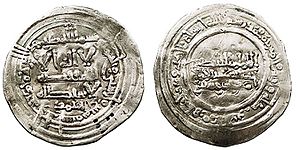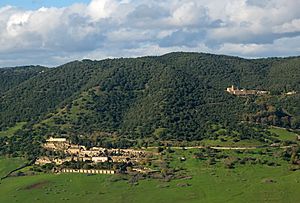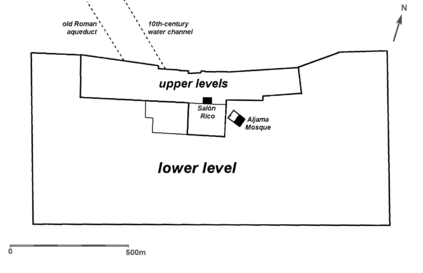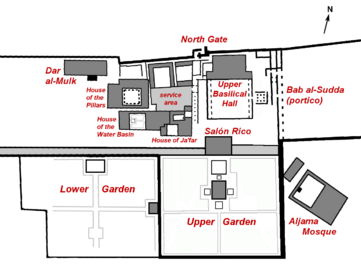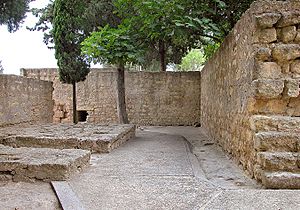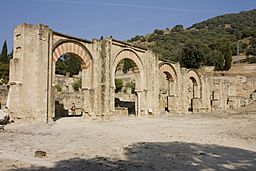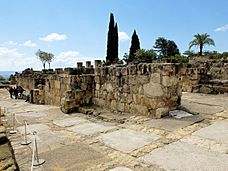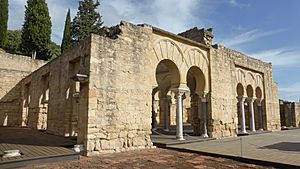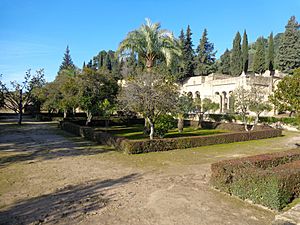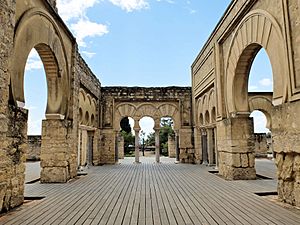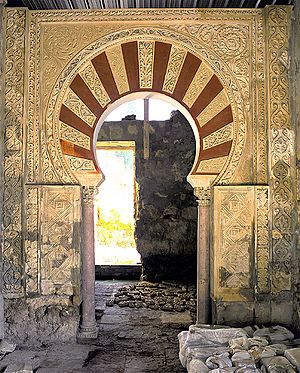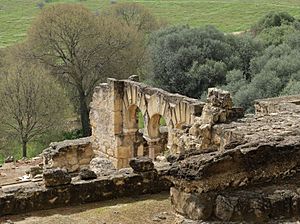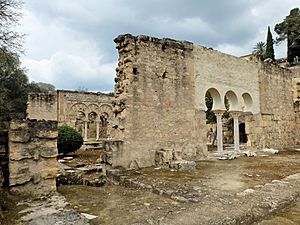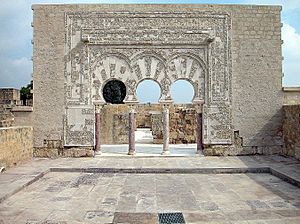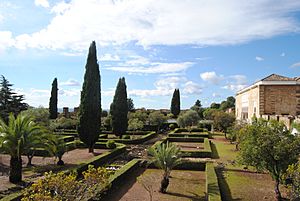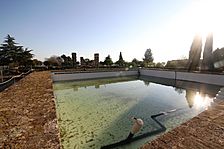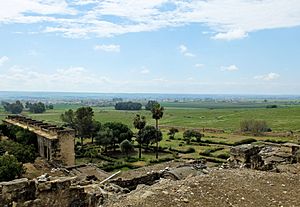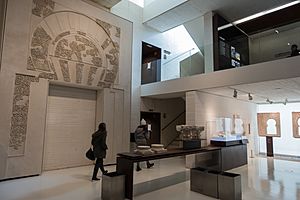Madinat al-Zahra facts for kids
|
Medina Azahara
|
|
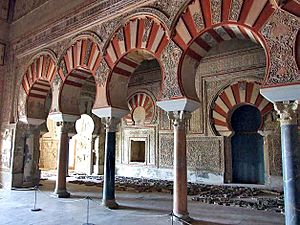
Reception hall of Abd ar-Rahman III
|
|
| Location | Córdoba, Spain |
|---|---|
| Coordinates | 37°53′17″N 4°52′01″W / 37.888°N 4.867°W |
| Site notes | |
| Website | Madinat al-Zahra |
| Official name: Caliphate City of Medina Azahara | |
| Type: | Cultural |
| Criteria: | iii, iv |
| Designated: | 2018 (42nd session) |
| Reference #: | 1560 |
| Region: | Europe and North America |
| Official name: Delimitación de Madinat al-Zahra | |
| Type: | Non-movable |
| Criteria: | Archaeological site |
| Designated: | 1 July 2003 |
| Reference #: | RI-55-0000379 |
Madinat al-Zahra or Medina Azahara (Arabic: مدينة الزهراء, romanized: Madīnat az-Zahrā, lit. 'the radiant city') was a grand palace-city built in the 10th century. It was located just outside Córdoba, in what is now Spain. Today, its ruins are an important archaeological site.
The city was created by Abd ar-Rahman III (who ruled from 912 to 961). He was a leader of the Umayyad dynasty and the first caliph (ruler) of Al-Andalus. Madinat al-Zahra served as the capital and government center for the Caliphate of Córdoba.
Abd ar-Rahman III built this city to show off his power. He had declared himself "caliph" in 929, a very important title. The new city was a symbol of his authority, like other powerful caliphates in the East. It also showed his strength against rivals like the Fatimid Caliphate in North Africa and the Abbasid Caliphate in Baghdad.
Building started around 936–940 and continued during his rule and that of his son, Al-Hakam II (961–976). The city had fancy reception halls, a large congregational mosque, offices, homes for important people, gardens, and workshops. Water was brought in through special channels called aqueducts.
However, after Al-Hakam II died, the city stopped being the main government center. It was attacked and destroyed during a civil war between 1010 and 1013. After that, people abandoned it and reused many of its building materials elsewhere.
Archaeologists began digging up the ruins in 1911. Only about 10 hectares (about 25 acres) of the 112-hectare city have been uncovered and partly rebuilt. This excavated area includes the main palaces. A museum about the site opened in 2009. In 2018, UNESCO named Madinat al-Zahra a World Heritage Site.
Contents
What's in a Name?
Popular stories say the city's name, az-Zahra (or Azahara in Spanish), came from Abd ar-Rahman III's favorite concubine. Some tales even say a statue of her stood at the entrance. While there were statues in the city, experts think this particular story is unlikely.
A simpler idea is that the name, which means "Flowering City" or "Radiant City," was chosen to be like other caliph cities. For example, the Abbasids had Madinat as-Salam ("City of Peace," now Baghdad). The Fatimids had Madinat al-Qahira ("Victorious City," now Cairo).
Some historians also believe the name might have been a challenge to the Fatimids. The Fatimids claimed to be related to Muhammad's daughter, Fatimah, who was also called az-Zahra ("the Radiant").
A Look at History
How the City Started
Abd ar-Rahman III was part of the Umayyad dynasty. This family once ruled the entire Islamic world. The title "caliph" meant being the political and spiritual leader of all Muslims.
In 750, the Abbasids took over from the Umayyads. They became caliphs and built a new capital in Baghdad. But in 756, Abd ar-Rahman III's ancestor, Abd al-Rahman I, brought the Umayyad family back to power in the Iberian Peninsula. This western part of the Muslim world was called Al-Andalus.
The Umayyad rulers in Al-Andalus, based in Cordoba, didn't call themselves caliphs at first. They used the title "emirs," which meant local Muslim rulers. They led the Emirate of Córdoba. Even though Arabic and Islamic culture thrived, the emir in Cordoba often struggled to control different groups.
When Abd ar-Rahman III became emir in 912, he worked hard to regain control. He used military force and diplomacy to strengthen his power across Al-Andalus. By 929, after many years of fighting, he felt strong enough to declare himself "caliph." This title made him equal to the Abbasid rulers in Baghdad, whose own power had weakened.
This decision might also have been a response to the rise of the Fatimid Caliphate in North Africa. The Fatimids challenged the Sunni caliphs of Baghdad. They also posed a threat to the Umayyad state in Al-Andalus.
Before Madinat al-Zahra, the Umayyad emirs lived and governed from the Alcázar in Cordoba. Many experts believe Abd ar-Rahman III wanted a new capital that showed off his caliphate's importance. Other caliphs, like the Abbasids and Fatimids, had also built their own grand palace-cities.
Building the City
Historical records say the new palace-city was started in 936. It was about 5 km (3 miles) west of Cordoba. Abd ar-Rahman III's son, Al-Hakam, was put in charge of the building work.
A writer from the 16th century, Al-Maqqari, named Maslama ibn 'Abdallah as the city's architect. But it's not clear how much he actually designed. Major building might have started later, around 940. Evidence shows it happened in stages, and the overall plan changed as work continued.
The city's mosque was finished in 941. By 945, the caliph was already living there. The road between the new city and Cordoba was paved in 946. In 947, the government offices, including the mint, moved from Cordoba to Madinat al-Zahra.
Building continued throughout Abd ar-Rahman III's rule (until 961) and Al-Hakam II's rule (961–976). Important officials often helped with the construction.
The entire city was surrounded by a strong wall with towers. However, it seems only the palaces had a wall at first. The outer city wall was added later, after homes had already started to appear outside the palace.
Abd ar-Rahman III also brought in thousands of old marble columns. Many came from Ifriqiya (even though it was controlled by the Fatimids). These were reused in the new city. Al-Hakam II also reportedly got many Roman statues and carved sarcophagi. These were used to decorate the grounds.
Some major buildings found at the site were built over older ones. This shows they belong to a later building phase. For example, the House of Ja'far and the Court of the Pillars were built over two or three smaller structures. The new buildings were larger and had different designs.
The Salón Rico, or Reception Hall of Abd ar-Rahman III, was built between 953 and 957. This is known from inscriptions in its decoration. The supervisor of the hall's construction was Abdallah ibn Badr, a top official. The decoration was overseen by the caliph's servant, Shunaif.
Experts believe a big remodeling of the palace happened in the 950s. This period saw larger, more impressive buildings with porticos and arches. These new structures often replaced older, simpler ones. The goal was to make the caliph's city look even more magnificent.
This time also matches a major government reorganization by Abd ar-Rahman III in 955. He was likely learning about the rich palaces and fancy court ceremonies in the new Fatimid capital, Mahdia, and the Byzantine capital of Constantinople. His desire to match these grand courts may explain the increased size of the new buildings.
The House of Ja'far might have been built a bit later than other 950s structures. Its decoration seems more advanced. This supports the idea that it was built for Ja'far, an important official of Al-Hakam II, between 961 and 971. This makes it the only major building identified from Al-Hakam II's time.
Life in the Palace-City
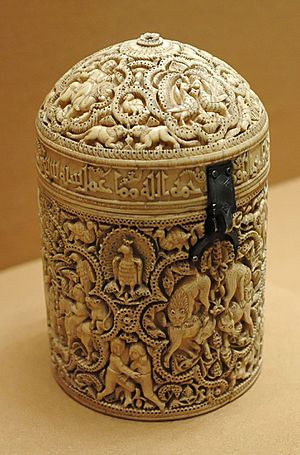
The palaces housed the caliph's family and many servants. The city also had a throne room (the Salón Rico), government offices, and workshops. These workshops made luxury items. Important officials had their homes there. In the lower parts of the city were markets and homes for regular workers.
The city had a manager, a judge, and a police chief. Under the educated caliph Al-Hakam II, there was also a huge library. Some say it had hundreds of thousands of books in Arabic, Greek, and Latin. The main mosque and smaller neighborhood mosques provided religious services.
The palaces were decorated with silks, tapestries, and other fancy objects. Many items made in the caliph's workshops were given as gifts. Some are now in museums and Christian cathedrals. Old stories describe a domed hall with a pool of liquid mercury. It reflected light and could be stirred to create amazing light ripples. Modern archaeologists have not found this hall.
The new caliphate also developed very detailed court rules. Grand festivals and receptions were held to impress foreign visitors. The city's layout seems to have guided guests on a specific path to the caliph's audience chamber. This path went through gardens and pools with views of the city. The caliph would sit at the back of his chamber, surrounded by officials. The architecture was designed to highlight his position.
Wealthy people and members of the caliph's family also built their own villas around Cordoba. This was a tradition that went back to earlier times. The caliph even kept some family members in these villas. This kept them away from the main power center in Madinat al-Zahra.
Decline and Destruction
When Al-Hakam II died in 976, his son Hisham II became ruler. Hisham was only 14 or 15 and didn't have much political experience. So, real power was taken by Ibn Abi Amir, a strong leader. He became the chief minister and took the title "al-Mansur" (or Almanzor).
In 978 or 979, Al-Mansur ordered a new palace city built for himself. He called it Madinat Az-Zahira ("the Shining City"). This new palace was meant to rival Madinat al-Zahra. Its exact location is still debated. Most think it was built east of Cordoba, near the Guadalquivir River. This would shift the center of power away from the old Umayyad palaces. The new palace was built in just two years.
When it was ready, Al-Mansur moved the government there. Madinat al-Zahra was left unused. The young caliph Hisham was kept in the old Alcázar in Cordoba.
After Al-Mansur died in 1002, his son Abd al-Malik al-Muzaffar took power. When al-Muzaffar died in 1008, his brother Abd al-Rahman Sanchuelo became leader. He was not as skilled as his father or brother. He tried to take the caliphate from Hisham, which caused big problems.
In February 1009, while he was away on a military trip, his enemies broke into the old Alcázar. They forced Hisham II to step down. At the same time, Madinat al-Zahira, Al-Mansur's palace, was looted and destroyed.
The next few years were very chaotic. There were many violent fights and changes in leadership. This period is known as the Fitna (civil war). Between 1010 and 1013, Cordoba was under attack. By the end of this time, Madinat al-Zahra, the city of Abd ar-Rahman III, had been looted and left in ruins.
For many years, people continued to take building materials from the city. This almost made it disappear. Over time, its remains were buried. Its location was not found again until the 19th century, with excavations starting in 1911.
City Layout
Where is Madinat al-Zahra?
Madinat al-Zahra is located about 4 miles (6.4 km) west of Córdoba. It sits on the slopes of Jabal al-Arus (meaning Bride Hill), facing the valley of the Guadalquivir river. It's sometimes called the Versailles of the Middle Ages.
The location was chosen for its beautiful views. It allowed the city to be built in a way that the palace buildings looked down over the city and the plains below. This showed the clear power of the Alcázar (citadel).
There was also a limestone quarry nearby, used for building. Other stones from up to 50 km (31 miles) away were also used. The city's construction led to new roads, water systems, and supply routes. Some of these, like parts of roads, quarries, aqueducts, and bridges, can still be seen today.
The land's shape greatly influenced the city's design. Madinat al-Zahra was built on three terraces, using the uneven ground to its advantage. Unlike the often winding and unplanned Muslim cities, this site was a rectangle. It covered 112 hectares (about 277 acres). It stretched about 1500 meters (almost a mile) from east to west and 750 meters (about half a mile) from north to south. Only the northern side was slightly changed to fit the hilly land.
Its location in the foothills of Sierra Morena allowed for a clear design. The palace was at the highest level. Its buildings were staggered up the mountain, showing their importance over the homes and the Great Mosque below.
The first terrace was for the caliph's private home. The next terrace held official buildings, like homes for ministers, guard rooms, offices, and gardens. The lowest level was the city itself, with homes, workshops, and the main mosque. A wall separated the upper palace complex from the lower city for privacy.
Archaeological digs show that the city had large empty areas. These kept the southern front of the fortress open, ensuring privacy and a beautiful countryside view. The lowest level had two main built areas: a western one with a grid-like street plan, and an eastern one with a less strict plan.
Two other building groups were outside but close to the city. One was a large villa on a big farm, later given to the state treasurer. The other, Turruñuelos, was a huge rectangular building, possibly a barracks.
Palace Areas (Upper Levels)
The city's highest point was at the center of its northern wall, near the palaces. This point is 215 meters (705 feet) above sea level. The lowest point, to the south near the river, is 70 meters (230 feet) lower. Most of the site slopes down towards the river. But in the central northern area, there were three distinct levels or terraces built into the hillside. There were height differences of 10 meters (33 feet) or more between them. The two upper levels were called the "Alcázar" (al-Qasr in Arabic). Most modern excavations have focused on the Alcázar and its palaces. These are the areas visitors can see today.
According to old Arabic writings, the three levels of the city had different uses. The top level had the caliph's private palaces and homes for his closest friends. The middle terrace held government buildings and homes for important officials. The much larger lower level was for common people and the army. This design showed the social and political order of the caliphate through the city's layout.
However, in reality, the levels weren't always so clearly separated. There were also many height differences within each level. The Alcázar also seemed to be divided into eastern and western parts. A north-south path, aligned with the city's northern gate, separated them. The eastern part was the "official" area, with administrative and reception buildings. The western part was the "private" area, with private homes for the caliph and his court.
Gates and Entrances
North Gate
The northern gate, called Bab al-Jibal ("Gate of the Mountains"), was at the city's highest point. It led directly into the middle of the Alcázar, or palace area. It is also known as the North Gate (Puerta Norte in Spanish). It had a bent entrance design and was protected by a tower. Today, it is the main entrance for visitors. To the west of the gate was the caliph's private palace (the Dar al-Mulk). To the east was the administrative area and the Upper Basilical Hall (the Dar al-Jund).
Bab al-Sudda (Eastern Portico)
The official entrance to the palace areas was further east. It was called Bab al-Sudda ("Forbidden Gate" or "Gate of the Threshold"). This gate was at one end of the long road that connected the palaces to Cordoba. It is believed to be where ambassadors and guests were welcomed.
The gate was a huge portico: a long line of large horseshoe arches running north-to-south. In front of it was a big open area, now called the Plaza de Armas. Old writings called it a ḫaṣṣa (open area). It was probably used for public ceremonies, military parades, and executions. On top of the gate's portico was a viewing platform. From here, the caliph could watch events on the plaza below. Inside the gate, a ramped street led up to the terrace of the Upper Basilical Hall.
Upper Basilical Hall (Dar al-Jund)
This building is called the "Upper Basilical Hall" today. It is thought to be the Dar al-Jund ("House of the Army" in Arabic), a name found in old texts. It was likely built in the 950s during a new building program.
The exact purpose of this large building is not certain. Experts believe it was used for administrative or official purposes. It might have been a reception hall for ceremonies or for welcoming ambassadors. The Dar al-Jund is mentioned as a meeting hall for the caliph's army officers.
The building is near the northeastern corner of the excavated area. It sits on a terrace west of the Bab al-Sudda entrance. It has a large basilica-style structure to the north and a big open courtyard to the south. Visitors reached this area by walking up a ramped street. This ramp started at the center of the Bab al-Sudda gate and wound its way up. The ramp was wide and gentle enough for visitors to stay on horseback. It even had benches where they could wait. It ended at a small court with a portico. From there, visitors entered the Dar al-Jund courtyard.
The Dar al-Jund courtyard is 54.5 meters (179 feet) wide and 51 meters (167 feet) deep. Its northern side has the wide entrance to the main hall. Its western and eastern sides had narrow porticos. The southern side was a simple wall. The main hall was 1.2 meters (4 feet) higher than the courtyard. Stairs and ramps led to its platform. The stairs were for people walking, and the ramps were for horses. The courtyard's remains were turned into a garden in the 1960s.
The main hall itself is the largest indoor space found in western Islamic palace architecture. It was big enough for up to 3000 people. The hall has five parallel rectangular rooms. They are placed side-by-side and open to each other through arches. Each room is about 20 meters (66 feet) long and 6.8 meters (22 feet) wide. The central room is slightly wider, about 7.5 meters (25 feet).
Each of these rooms opens onto a sixth room to the south. This room is perpendicular to the others, about 30 meters (98 feet) long. It opens to the courtyard through five wide archways. Other smaller rooms are nearby. The building's decoration was simple compared to other royal buildings. The walls were stone and plastered, with little ornament except a red dado near the bottom. The floors were brick, not stone. Only the column tops were carved. However, the walls might have been covered with tapestries. Curtains might have hung across the arches.
The hall's design is a bit unclear. The central room is wider, and its entrance has three arches instead of two. The three middle rooms are connected by wide central doors with triple arches. The two outer rooms are connected to the inner ones by three simple doors. During official events, the caliph likely sat in the middle of the back wall of the central room.
Dar al-Mulk
The Dar al-Mulk, or "Royal House," is a palace mentioned in old writings. Archaeologists believe it is the building on the city's highest terrace, in the northwest part of the excavated area. It is thought to be one of the first buildings constructed here. It was also one of the first to be excavated in 1911. Historical sources also say that in 972, the Dar al-Mulk was used to educate Prince Hisham, who would later become caliph.
The main building had three parallel rectangular halls. They were oriented east-west. The halls were entered from the south. The first two halls each had three equally sized openings or doorways. The third hall, at the back, was much smaller with only one door. Each hall also had small square rooms on both sides.
The first main hall might have been an entrance hall. The second might have been a reception room. The third hall might have been a private sitting area, with its side rooms as bedrooms. The second and third halls have been partly rebuilt. But the first (southernmost) hall is gone. It was at the very edge of the terrace, 15 meters (49 feet) above the next level. In front of the eastern corner of this hall, there are remains of a staircase that led down to the terrace below. On the east side of the main building is another apartment. It has a courtyard, a portico of arches, and a hall. This was built over an old bathhouse.
The building was richly decorated. The doorways, some rectangular and some arched, had geometric and plant-like (arabesque) designs. The floors were paved with geometric patterns. The building's outer front, which faced south over the terrace wall, had three decorated doorways. It also had a blind arcade of false windows above.
House of the Water Basin
The House of the Water Basin (Vivienda de la Alberca in Spanish) is south of the Court of the Pillars. It was part of a group of homes between the Dar al-Mulk and the Salon Rico. This house is believed to be from the first years of Madinat al-Zahra's construction. Some parts of its layout were likely changed later.
One expert, Antonio Vallejo Triano, thinks this house was where Al-Hakam II lived before he became caliph in 961. The site was excavated between 1975 and 1982. As of 2018, archaeologists were still studying it.
The building is laid out along an east-west line. It is centered around a square courtyard. Its original entrance was on the north side and led right into the courtyard. On both the west and east sides were two rectangular rooms, one behind the other. Their entrances were aligned with the courtyard's center. Smaller rooms were also along the sides of the building.
Behind the eastern rooms was a private bathhouse or hammam. It had three rooms of decreasing size. They were heated using the old Roman hypocaust system under its marble floors. Marble decoration was added to the bath by Ja'far in 961-62.
The house's courtyard had two symmetrical sunken gardens. It also had a water basin in the middle of the courtyard's western side, which gives the house its name. The gardens were surrounded by raised walkways. Water channels also ran along the courtyard's edges and brought water to the basin. The gardens were planted with low-growing plants like lavender, oleander, myrtle, basil, and celery.
The main halls on either side were accessed through an arcade with three horseshoe arches. These arches rested on columns and are partly rebuilt today. The arches are framed by an alfiz filled with carved plant designs. One expert, D. Fairchild Ruggles, says this garden is also known as the "Prince's Garden." It was likely enjoyed by important people living in the palaces.
House of Ja'far
The large "House of Ja'far" was built over what were originally three smaller houses. It is located between the Court of the Pillars to the northwest and the Salón Rico to the southeast. Because its decoration is more advanced, it was built after 961, during the rule of Al-Hakam II. This supports the idea that it was built for Ja'far, an important official of Caliph Al-Hakam II between 961 and 971. It was excavated in 1970. The decorated portico of the main courtyard has been rebuilt since 1996.
The building has three areas, each with its own courtyard. The larger southern part was likely for official business and receptions. It was entered from the west. It centered around a square courtyard paved with violet limestone. A second story might have existed here, as suggested by a staircase.
On the east side of the courtyard is a richly decorated portico, rebuilt since 1996. It led to three rectangular reception rooms. Behind these rooms were smaller square rooms. One of these rooms had a latrine. Another led to other parts of the house. These other areas were reached through a smaller square courtyard in the northeast. This courtyard had a round water basin in its center.
On the north side of this courtyard was a private apartment, in the house's northeast corner. On the west side of the courtyard was a larger rectangular courtyard, surrounded by rooms. This served as a service area for servants and staff. Antonio Vallejo Triano believes the house's plan shows it was not for a family. Instead, it was designed for one high-ranking person.
The Upper Garden and the Central Pavilion
The Upper Garden (Jardín Alto in Spanish) is in front of the Salón Rico. It sits on a raised terrace, 10 meters (33 feet) higher than the areas around it. The terrace is artificial, but builders probably used a natural hill. Its walls are strengthened with rectangular supports. The Lower Garden was on its east side, and the Aljama Mosque was on its west. The mosque was reached by a covered path along the terrace wall. To the south is another large, unexcavated garden.
The garden itself was purely for beauty. Along with the Lower Garden, it is one of the earliest examples of the traditional four-part Islamic garden. This style is also called chahar bagh in the Persian tradition. Around its edge ran a walkway 4 meters (13 feet) wide. Two other walkways divided the garden into four parts. The gardens were sunken about 50 to 70 centimeters (20-28 inches) below the walkways. This meant the low-growing plants did not block views. The area has been replanted in modern times. But there is evidence that herbs and shrubs were originally planted. These included myrtle, lavender, hackberry, oleander, basil, and jujube.
In the middle of the garden's northern side is a large water basin. It measures 19 by 19 meters (62 by 62 feet) and is 2 meters (6.6 feet) deep. The gardens gently slope from north to south. This allowed the water basin to irrigate them. Water channels ran along the walkways to spread water.
South of this basin, in the middle of the gardens, was the large "Central Pavilion." Its construction dates to 956 or 957. Very little of it remains compared to buildings like the Salón Rico. It is still being investigated. It was a rectangular building with three parallel halls. Its main entrance faced the Salón Rico.
The building stood on a platform one meter (3.3 feet) higher than the walkways. On all four sides was a small water basin. These basins were the same height as the platform. The water basins might have been designed so that anyone inside the pavilion would see the sky reflected in the water. An observer from outside would see the pavilion reflected in the water. Also, the pavilion's position meant both it and the Salón Rico would be reflected in the larger northern water basin. These pools of water would also reflect light into both buildings through their front arches. They might have made observers feel like the buildings were "floating" on water.
The Lower Garden
The Lower Garden (Jardin Bajo in Spanish) was on a lower level. It was on the east side of the Upper Garden and south of the Dar al-Mulk. It has not been fully excavated. But it is known to have had an equal four-part division, much like the Upper Garden's first design. It was one of the largest gardens in the city. It was probably created during the first phase of construction at Madinat al-Zahra.
The garden was originally 125 meters (410 feet) long from north to south and 180 meters (590 feet) wide from east to west. But when the Upper Garden was built to the east, its width was reduced by 22 meters (72 feet). It was surrounded by a walkway 4 meters (13 feet) wide. Two more walkways crossed in the middle of the gardens. The gardens between the walkways were sunken, like other examples in the city. It is not clear what plants were grown there. But limited evidence suggests herbs and shrubs similar to those in the Upper Garden, as well as flax.
At the middle of the garden's eastern edge, along the wall of the Upper Garden, was a large rectangular support. At the base of this support was a water basin. Water from the Upper Garden probably flowed into it from above. A pavilion might have also been on top of it, with views over the Lower Garden. But not enough remains have been found to prove this.
Water Systems
The palace was built near a 1st-century Roman aqueduct. This aqueduct ran from the Sierra Morena to Cordoba. But it was several meters below the palace. So, a new branch was built further back to bring water to the higher levels. The old Roman aqueduct, now diverted, was used as a main sewer. It carried away rain and waste water through a complex system of small channels. Many old food and ceramic pieces have been found here. Besides the aqueducts, several new bridges were built. Two of them still exist today. They served the new roads between the palace-city and Cordoba.
Architectural Style and Impact
Madinat al-Zahra played a big role in creating a unique Islamic architecture style in Al-Andalus. This style is also called "Moorish" architecture. It also helped establish a special "caliphal" style in the 10th century.
The main mosque of Madinat al-Zahra looks a lot like the Great Mosque of Córdoba. It copied its double-tiered arches. The horseshoe arch, already seen in the Great Mosque of Cordoba, became very common in Madinat al-Zahra. It took on its special shape: about three-quarters of a circle, usually inside a rectangular frame called an alfiz.
The detailed arabesque decoration, carved into many wall surfaces, shows influences from the Sassanian and Abbasid Iraq. But it also has unique details. The basilical royal reception hall, like the Salon Rico, was another special creation here. It became a key feature of palace architecture in this region. This was different from the domed and vaulted halls found in the eastern part of the Islamic world.
The Lower Garden and Upper Garden of Madinat al-Zahra are the earliest examples found of a symmetrically divided garden in the western Islamic world. They are also among the earliest examples in the entire Islamic world. They are also the first in the region to combine such gardens with a system of terraces. This type of garden likely came from Persian gardens (chahar bagh) far to the east. They were brought to the west by Umayyad rulers.
Courtyards with symmetrically divided gardens, later known as riyads (or riads), became a common feature of later Andalusi palaces. This includes the Alhambra, and also influenced Moroccan architecture and beyond.
Digging Up the Past
Archaeological digs at the site began in 1911. Spanish architect Ricardo Velázquez Bosco led the first work. Others continued the work over the years, including Félix Hernández Giménez, Rafael Manzano Martos, Antonio Vallejo Triano, and José Escudero Aranda.
The Salon Rico, the most decorated building, was excavated in 1946. Thanks to its partly preserved walls and many decorative pieces, it was rebuilt. Restoration of the hall's decorations continues today.
Excavation and restoration work are still ongoing, depending on funding from the Spanish government. In 2020, archaeologists found a gateway that marked the eastern entrance to the 10th-century palace. It had been missing for over a thousand years.
The parts of the site that haven't been dug up yet, about 90% of the total area, are at risk. Illegal housing construction threatens them. A 2005 report said that the local government in Córdoba was not enforcing a 1995 law. This law was meant to protect the site from development. As a result, construction companies are building houses on these unexcavated areas.
The Museum
A new archaeological museum dedicated to Medina Azahara opened in 2009. It is located at the edge of the site. The museum building was built low, with much of it underground. This was done to keep the views of the landscape from the ruins clear. The museum, designed by Nieto Sobejano Arquitectos, won the Aga Khan Award for Architecture in 2010.
Images for kids
See also
 In Spanish: Medina Azahara para niños
In Spanish: Medina Azahara para niños


